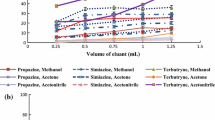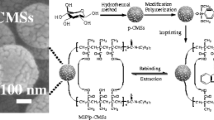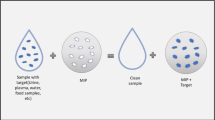Abstract
Molecularly imprinted polymer (MIP) microspheres with diameters in the range 60–500 μm were synthesized in a continuous segmented flow microfluidic reactor and used as packing material for microtraps for the selective separation of benzo[a]pyrene (BAP) from environmental aqueous samples. The synthesis involved the pumping of monodisperse droplets of acetonitrile containing methacrylic acid as the functional monomer, BAP as a template, and ethylene glycol dimethacrylate as the cross-linking monomer into the microchannels of the microfluidic reactor. The microspheres showed high adsorption capacity and selectivity for BAP in aqueous solutions; both are important for the environmental monitoring and analysis of BAP. The adsorption capacity for BAP of the smallest MIP microspheres (size range 60–80 μm), prepared as part of this study, was 75 mg g-1 in aqueous solutions; furthermore, this adsorption capacity was close to 300 % higher than that of commercially used activated carbon. Microtraps packed with MIP retained BAP intact for at least 30 days, whereas microtraps packed with activated carbon for BAP showed 40 % reduction in BAP concentration for the same period. This study has demonstrated that MIP microtraps have significant potential for the selective enrichment and preservation of targeted polycyclic aromatic hydrocarbons from complex environmental samples.





Similar content being viewed by others
References
Afghan BK, Chau ASY (1989) Analysis of trace organics in the aquatic environment. CRC, Boca Raton
Bostrom C, Gerde P, Hanberg A, Jernstrom B, Johanson C, Kyrkland T, Rannug A, Tornquist M, Vicotrin K, Westerholm R (2002) Cancer risk assessment, indicators, and guidelines for polycyclic aromatic hydrocarbons in the ambient air. Environ Health Perspect 110:451–466
Arey J (1998) In: Nielson AH (ed) PAHs and related compounds. Handbook of environmental chemistry, vol 3. Springer, Berlin
US Environmental Protection Agency (1984) Guidelines establishing test procedures for analysis of pollutants. 40 CFT. 135, 1-120. Fed Regist
European Parliament Council (2001) Decision No 2455/2001/EC of the European Parliament and of the Council of 20 November 2001 establishing the list of priority substances in the field of water policy and amending Directive 2000/60/EC (text with EEA relevance). Off J Eur Communities L 331:1–5
Lopez-Avila L (1999) Sample preparation for environmental analysis. Crit Rev Anal Chem 29:195–230
Pawliszyn J, Pedersen-Bjergaard S (2005) Analytical microextraction: current status and future trends. J Chromatogr Sci 44:291–307
de Fatima Alpendurada M (2000) Solid-phase microextraction: a promising technique for sample preparation in environmental analysis. J Chromatogr A 889:3–14
Kostopoulou K, Nikolaou A (2008) Analytical problems and the need for sample preparation in the determination of pharmaceuticals and their metabolites in aqueous environmental matrices. Trends Anal Chem 27:1023–1035
Wulff G, Sarhan A (1972) Use of polymers with enzyme-analogous structures for the resolution of racemates. Angew Chem Int Ed 11:341–345
Mayes AG, Mosbach K (1997) Molecularly imprinted polymers: useful materials for analytical chemistry? Trends Anal Chem 16:321–332
Sellergren B (2000) Imprinted polymers with memory for small molecules, proteins, or crystals. Angew Chem Int Ed 39:1031–1037
Spivak D, Simon R, Campbell J (2004) Evidence for shape selectivity in non-covalently imprinted polymers. Anal Chim Acta 504:23–30
Dai S, Burleigh MC, Ju YH, Gao HJ, Lin JS, Pennycook SJ, Barnes CE, Xue ZL (2000) Hierarchically imprinted sorbents for the separation of metal ions. J Am Chem Soc 122:992–993
Rao TP, Kala R, Daniel S (2006) Metal ion imprinted polymers—novel materials for selective recognition of inorganics. Anal Chim Acta 578:105–111
Zhao WF, Fang BH, Li N, Nie SQ, Wei Q, Zhao CS (2009) Fabrication of pH-responsive molecularly imprinted polyethersulfone particles for bisphenol-A uptake. J Appl Polym Sci 113:916–921
Chen L, Xu S, Li J (2011) Recent advances in molecular imprinting technology: current status, challenges and highlighted applications. Chem Soc Rev 40:2922–2942
Krupadam RJ, Bhagat B, Wate SR, Bodhe GL, Sellergren B, Anjaneyulu Y (2009) Fluorescence spectrophotometer analysis of polycyclic aromatic hydrocarbons in environmental samples based on solid Phase extraction using molecularly imprinted polymer. Environ Sci Technol 43:2871–2877
Krupadam RJ, Khan MS, Wate SR (2010) Removal of probable human carcinogenic polycyclic aromatic hydrocarbons from contaminated water using molecularly imprinted polymer. Water Res 44:681–688
Krupadam RJ, Bhagat B, Khan MS (2010) Highly sensitive determination of polycyclic aromatic hydrocarbons in ambient air dust by gas chromatography-mass spectrometry after molecularly imprinted polymer extraction. Anal Bioanal Chem 397:3097–3106
Krupadam RJ (2011) An efficient fluorescent polymer sensing material for detection of traces of benzo[α]pyrene in environmental samples. Environ Chem Lett 9:389–395
Song X, Li J, Xu S, Ying R, Ma J, Liao C, Liu D, Yu J, Chen L (2012) Determination of 16 polycyclic aromatic hydrocarbons in seawater using molecularly imprinted solid-phase extraction coupled with gas chromatography-mass spectrometry. Talanta 99:75–82
Sellergren B, Andersson L (1990) Molecular recognition in macroporous polymers prepared by substrate analog imprinting strategy. J Org Chem 55:3381–3383
Rockne KJ, Strand SE (1998) Biodegradation of bicyclic and polycyclic aromatic hydrocarbons in anaerobic enrichments. Environ Sci Technol 32:3962–3967
Zhu QZ, Haupt K, Knopp D, Neissner R (2002) Molecularly imprinted polymer for metsulfuron-methyl and its binding characteristics for sulfonylurea herbicides. Anal Chim Acta 468:217–227
Bomchil G, Herino R, Barla K, Pfister JC (1983) Pore size distribution in porous silicon studied by adsorption isotherms. J Electrochem Soc 130:1611–1614
Krupadam RJ, Ahuja R, Wate SR (2007) Benzo(α)pyrene imprinted polyacrylate nanosurfaces: Adsorption and binding characteristics. Sens Actuators B 124:444–451
Pichon V, Chapuis-Hugon F (2008) Role of molecularly imprinted polymers for selective determination of environmental pollutants—a review. Anal Chim Acta 622:48–61
Turner NW, Piletska EV, Karim K, Whitcombe M, Malecha M, Magan N, Baggiani C, Piletsky SA (2004) Effects of the solvent on recognition properties of molecularly imprinted polymer specific for ochratoxin A. Biosens Bioelectron 20:1060–1067
Ye L, Yu Y, Mosbach K (2000) Towards the development of molecularly imprinted artificial receptors for the screening of estrogenic chemicals. Analyst 126:760–765
Ariza JLG, Morales E, Sanchez-Rodas D, Giraldez I (2000) Stability of chemical species in environmental matrices. Trends Anal Chem 19:200–209
McSheehy S, Szpunar J, Morabito R, Quevauviller PH (2003) The speciation of arsenic in biological tissues and the certification of reference materials for quality control. Trends Anal Chem 22:191–209
Hadjiev D, Dimitrov D, Martinov M, Sire O (2007) Enhancement of the biofilm formation on polymeric supports by surface conditioning. Enzyme Microbial Technol 40:840–848
Saiz-Jimenez C (1997) Biodeterioration vs biodegradation: the role of microorganisms in the removal of pollutants deposited on historic buildings. Int J Biodeter Biodegrad 40:225–232
Gomes S, Nogueira R, Oliveira JM, Peixoto P, Brito AG (2009) Determination of total and available fractions of PAHs by SPME in oily wastewaters: overcoming interference from NAPL and NOM. Environ Sci Pollut Res 16:671–678
Acknowledgments
R.J.K acknowledges financial support from the Council of Scientific and Industrial Research, New Delhi, and the Planning Commission, Government of India, under the Molecular Environmental Science and Engineering Research program.
Author information
Authors and Affiliations
Corresponding author
Rights and permissions
About this article
Cite this article
Krupadam, R.J., Korde, B.A., Ashokkumar, M. et al. Novel molecularly imprinted polymeric microspheres for preconcentration and preservation of polycyclic aromatic hydrocarbons from environmental samples. Anal Bioanal Chem 406, 5313–5321 (2014). https://doi.org/10.1007/s00216-014-7952-z
Received:
Revised:
Accepted:
Published:
Issue Date:
DOI: https://doi.org/10.1007/s00216-014-7952-z




